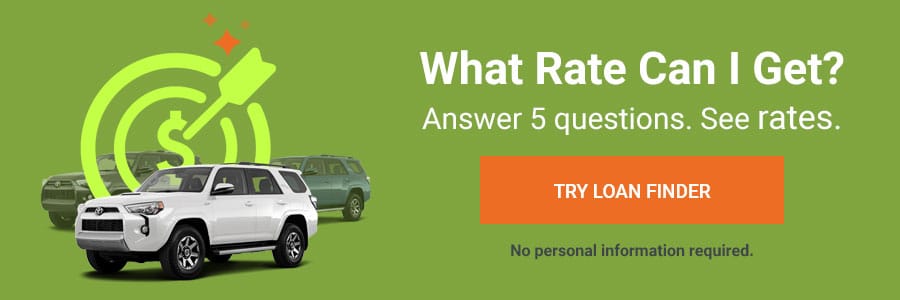What’s Negative Equity on a Car Loan?
;)

Negative equity on a car loan can set you back financially. Here’s what you should know to avoid it.
Has anyone ever told you that a new car loses value as soon as it leaves the lot? If so, you might have shrugged it off since, well, it sounds a little ridiculous. After all, cars are expensive and can’t lose value that fast, right? Wrong.
According to CARFAX, a car loses more than 20% of its value within the first year after it’s driven off the lot. This depreciation, as well as the wrong car loan or terms, can create what’s called negative equity, even if you make all of your loan payments on time.
What Is Negative Equity on a Car Loan?
Negative equity, sometimes referred to as being “upside down”, on a car loan happens when you owe more on your loan than your vehicle is worth.
To find out how much negative equity you have, start by figuring out how much money your car is really worth, commonly referred to as the retail value. You can easily find your vehicle’s retail value by visiting trusted sites like Kelley Blue Book (KBB) or Edmunds and using their car appraisal tools.
Once you find your vehicle’s value, subtract it from your current vehicle’s loan balance. This number is the amount of negative equity that you have.
For example, if your car is worth $5,000, but you still have $10,000 left on your loan, you have $5,000 in negative equity.
Another way that your negative equity is reflected is in your loan-to-value (LTV) ratio. This ratio is found by dividing your loan amount by your vehicle’s current retail value. If your LTV is over 100%, your loan is worth more than your car and your equity is in the red. For lenders, including those offering refinancing, a high LTV could be reason enough to deny your loan.
If you need help figuring out your LTV, you’re not alone. Try our calculator below:
Car (LTV) Loan-to-Value Calculator
How Does Negative Equity Happen?
Negative equity is always best avoided, but that can be easier said than done. Here are a few reasons you may find yourself upside down.
You made a small down payment
Making a small down payment on your auto loan is an easy way to set yourself up for negative equity. The more money you pay upfront, the more equity you have in your vehicle, which can help you get ahead of your vehicle’s depreciation.
Additionally, paying more towards your down payment can help lessen the amount of interest you’ll pay over the life of the loan. If you make too small of a down payment, this interest can add up quickly and extend the life of the loan. The longer you’re stuck paying it off, the more negative equity you will potentially build since your car will continue to lose value.
You bought a car outside of your budget
If you finance a car that is more expensive than you can afford (or rolled over debt from a previous auto loan), you’ll likely drive off the lot already upside down on the loan.
If you struggle with making your monthly payments and get behind on your loan, you can quickly rack up more negative equity. In order to afford your monthly payments, you might consider stretching out the length of your loan term — which would make you even more upside down on the loan.
Your car loan has a long term
The most common length of a car loan, according to Edmunds, is 72 months, or 6 years. Because your car is likely to only be worth 40% of what you originally purchased it for after only five years, a long loan term could stretch your payments out for longer than your car will hold value.
You drive more miles than average
People drive vehicles for different reasons, some just to commute to and from work and others test their limits for entertainment. No judgment here if you’re one of the latter! However, if you are, you need to know that your car will likely depreciate more quickly than the same model used as a commuter, especially if you rack up miles fast. This will lower your vehicle’s value and open you up to more negative equity.
You don’t keep up with routine maintenance
Routine maintenance on a vehicle can seem never ending and expensive, but not keeping up with it could cost you quite a bit of equity in your car. Just like humans, vehicles need to stay healthy in order to extend their life.
If your car becomes undriveable, it will hold little to no value as a trade-in or even a private party sale, but you’ll still need to pay off the entire loan.
Think Carefully Before Rolling Over Negative Equity
Rolling over negative equity into a new auto loan is sometimes an option when you trade in your vehicle. Your lender pays off your original loan and consolidates your negative equity by adding it to your new auto loan.
This sounds tempting to folks who’s trade-in value is low and won’t cover the full cost of their new vehicle.
However, if you roll over your negative equity, you will extend the life and cost of your new loan. This can cause you to pay more in interest and, unfortunately, set you up to take on even more negative equity if you can’t keep ahead of your new vehicle’s depreciation.
How much negative equity can you roll over?
The amount of negative equity that you can roll over into a new loan is up to the new lender.
To figure out how much you will be approved for, your new lender will need to review your income, credit report, credit score, and other factors. If you have bad credit, you might not be allowed to roll over your negative equity at all.
How Can I Get Rid of Negative Equity on My Car Loan?
Once you accumulate negative equity, you’ll want to get rid of it as soon as you can. Here are a few strategies for getting back in the black:
- Pay off your negative equity in one lump sum: If you can afford to make a lump sum payment in the amount of your negative equity, you should consider doing so. This is the only automatic way to get rid of your negative equity and stop yourself from gaining more negative equity due to interest charges.
- Pay off your loan aggressively: Once you find out how much negative equity you have, you will want to pay it off as quickly as possible. The longer that you wait to get ahead of your negative equity, the more it will build. To do so, consider making larger than normal payments or making as many extra payments as you can.
- Refinance your loan: By refinancing your auto loan, you can often get better terms, including a lower interest rate or shorter loan length. If you qualify for refinancing, these terms could help you pay off your loan more quickly and avoid excessive interest charges that up your negative equity.
Can You Sell Your Vehicle if You Have Negative Equity?
If you have an upside down car loan, you’ll want to try to recoup as much of the value of your car as possible and selling can be a great way to do that. Luckily, you don’t need to have positive equity first, although it’s a good idea.
You can sell it privately
With a private sale, you get to decide the price of your vehicle and keep all of the profits. This can help you pay off your negative equity faster, if not completely, depending on how successful your sale is.
Just make sure you’re not undervaluing your car just to sell it quickly. You’ll still need to pay back your loan in full, so your aim should be to get the most money possible for your vehicle.
You can trade it in
Trading in your vehicle when you have negative equity on your current car loan can get a little messy.
Not only do dealerships tend to pay less than if you sold it in a private sale, leaving you with even more negative equity, but they also have control over whether or not you’ll be able roll your negative equity into a new car loan. If they decide against it or approve a lower amount than you need to cover your negative equity, you will be stuck paying the difference before being able to purchase your new car.
You can sell it to a dealership
If you’re looking to unload your vehicle quickly in order to stop your negative equity from growing, you have the option of selling it to a dealership. While trading in your vehicle is more like credit towards a new vehicle, selling it directly is like getting a cash refund. In fact, some dealerships will even pay you in cash!
Just like with trade-ins, a dealership will often pay you less for your vehicle than it would be worth in a private sale. This allows the dealer to turn your vehicle around for a profit.

How To Avoid Negative Equity on a Car Loan in the Future
In order to avoid negative equity in the future, make sure to think about the following before you purchase your next car:
- Buy a car you can pay for upfront: By buying a car that you can pay for upfront, you will owe nothing to a bank and hold all of the equity at the time of purchase. If you usually buy your vehicles brand new, you might want to consider a used car. Remember, you don’t need to drive an expensive car, it just needs to be reliable.
- Research a car’s value thoroughly before buying it: If you don’t do your research, you could easily overpay for your vehicle. Whether you’re buying it in a private sale, or at a dealership, be sure to research the true market value of the car on sites like KBB and Edmunds.
- Make a larger down payment: Putting more money down on your auto loan will lessen the payments that you need to make overtime. By doing so, you’ll get ahead of the depreciation on your car.
- Opt for shorter loan terms if you can afford larger car payments: If you can afford larger payments, opting for a shorter loan term can help you pay off your loan more quickly. The faster you pay off your loan, the more equity that you will retain in your vehicle.
- Pay off your current auto loan first: Paying off your old loan before purchasing your next vehicle will ensure that you don’t start off a new loan with negative equity.
- Create a budget for auto maintenance: Creating a budget for your car’s maintenance will help you ensure that you are able to keep your car running at peak performance for longer. In turn, this can help you retain value in your car.
Negative Equity Happens, It’s Okay!
Negative equity is always best avoided, but if you find yourself with it, that is okay. Take a deep breath, come up with a plan, and stick to it!
Once you’re back in the black, learn from experience and make sure that you have a plan for keeping your next loan right side up.

